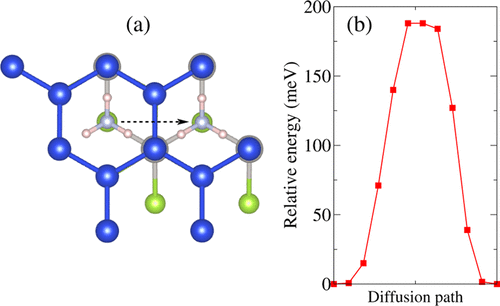当前位置:
X-MOL 学术
›
ACS Appl. Mater. Interfaces
›
论文详情
Our official English website, www.x-mol.net, welcomes your
feedback! (Note: you will need to create a separate account there.)
Silicene on Monolayer PtSe2: From Strong to Weak Binding via NH3 Intercalation
ACS Applied Materials & Interfaces ( IF 8.3 ) Pub Date : 2018-01-16 00:00:00 , DOI: 10.1021/acsami.7b17304 Shahid Sattar 1 , Nirpendra Singh 1 , Udo Schwingenschlögl 1
ACS Applied Materials & Interfaces ( IF 8.3 ) Pub Date : 2018-01-16 00:00:00 , DOI: 10.1021/acsami.7b17304 Shahid Sattar 1 , Nirpendra Singh 1 , Udo Schwingenschlögl 1
Affiliation

|
We study the properties of silicene on monolayer PtSe2 by first-principles calculations and demonstrate a much stronger interlayer interaction than previously reported for silicene on other semiconducting substrates. This fact opens the possibility of a direct growth. A band gap of 165 meV results from inversion symmetry breaking and large spin-splittings in the valence and conduction bands from proximity to monolayer PtSe2 and its strong spin–orbit coupling. It is also shown that the interlayer interaction can be effectively reduced by intercalating NH3 molecules between silicene and monolayer PtSe2 without inducing charge transfer or defect states near the Fermi energy. A small NH3 diffusion barrier makes intercalation a viable experimental approach to control the interlayer interaction.
中文翻译:

单层PtSe 2上的硅酮:通过NH 3嵌入从强结合到弱结合
我们通过第一性原理计算研究了硅在单层PtSe 2上的特性,并证明了比以前报道的硅在其他半导体衬底上的层间相互作用强得多。这一事实为直接增长提供了可能性。165 meV的带隙是由于反演对称性破坏以及从接近单层PtSe 2的价带和导带的大自旋分裂及其强烈的自旋-轨道耦合引起的。还表明,通过在硅和单层PtSe 2之间插入NH 3分子可以有效地减少层间相互作用,而不会在费米能量附近引起电荷转移或缺陷状态。小NH 3 扩散阻挡层使插层成为控制层间相互作用的可行实验方法。
更新日期:2018-01-16
中文翻译:

单层PtSe 2上的硅酮:通过NH 3嵌入从强结合到弱结合
我们通过第一性原理计算研究了硅在单层PtSe 2上的特性,并证明了比以前报道的硅在其他半导体衬底上的层间相互作用强得多。这一事实为直接增长提供了可能性。165 meV的带隙是由于反演对称性破坏以及从接近单层PtSe 2的价带和导带的大自旋分裂及其强烈的自旋-轨道耦合引起的。还表明,通过在硅和单层PtSe 2之间插入NH 3分子可以有效地减少层间相互作用,而不会在费米能量附近引起电荷转移或缺陷状态。小NH 3 扩散阻挡层使插层成为控制层间相互作用的可行实验方法。











































 京公网安备 11010802027423号
京公网安备 11010802027423号